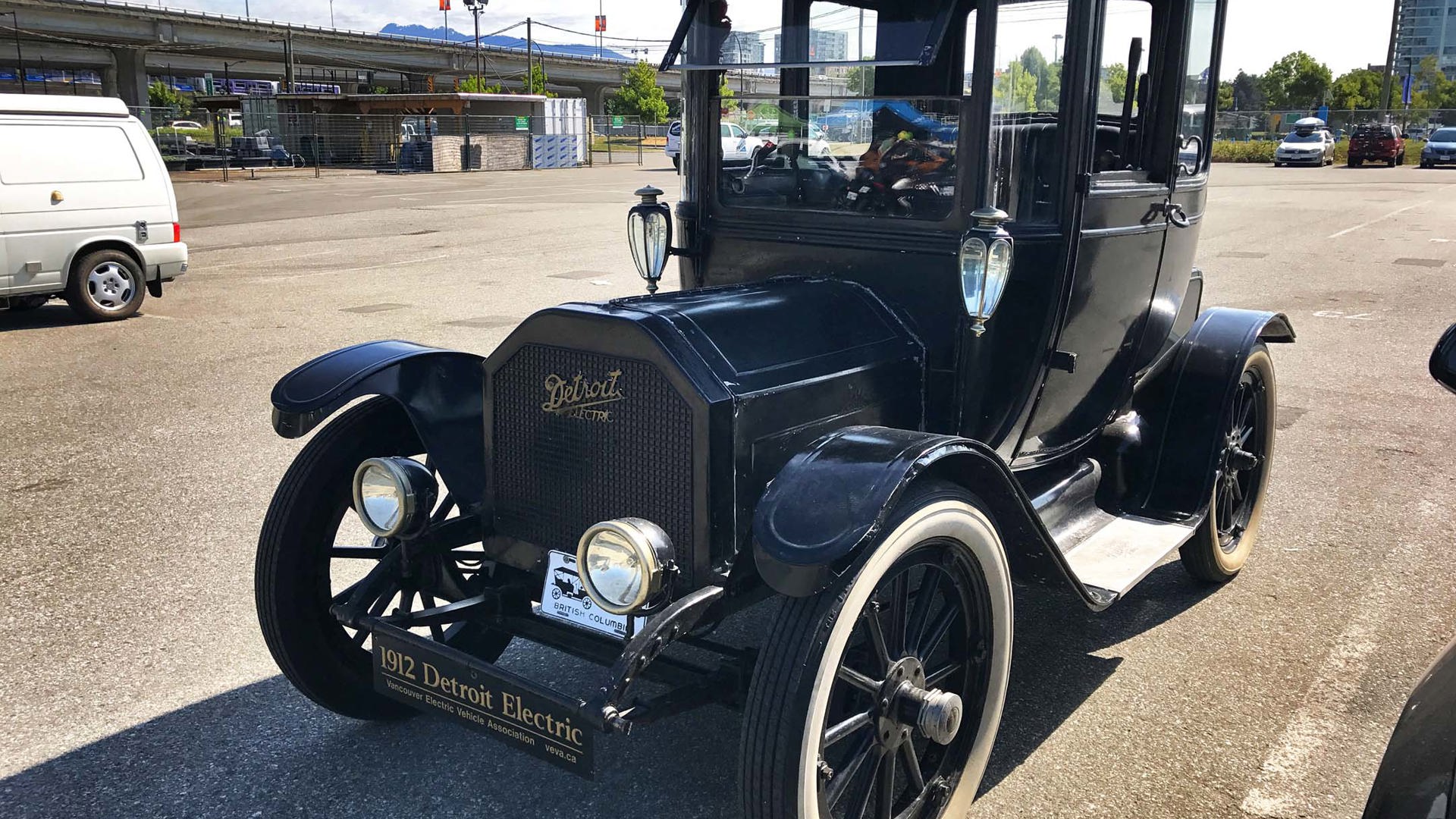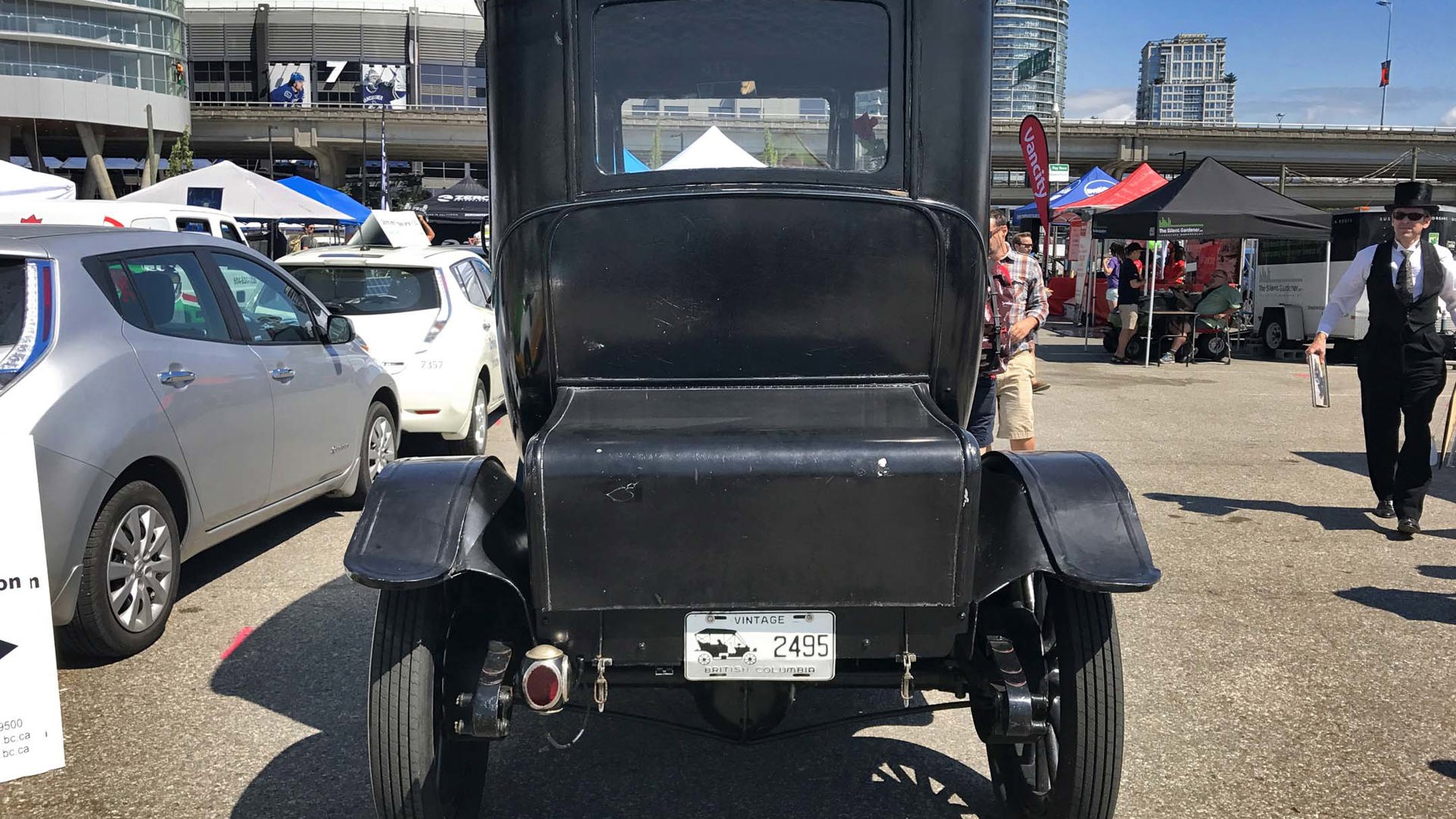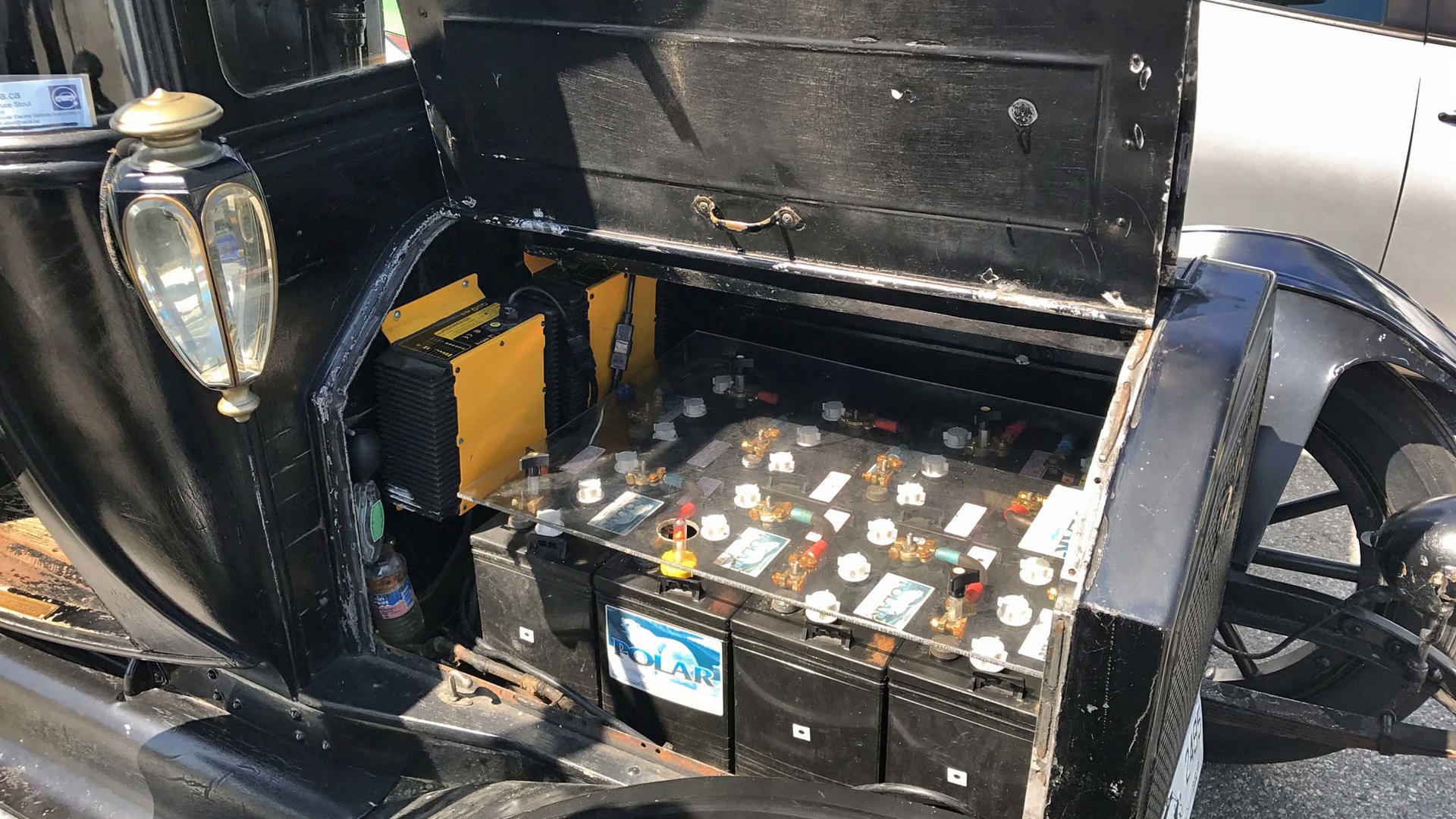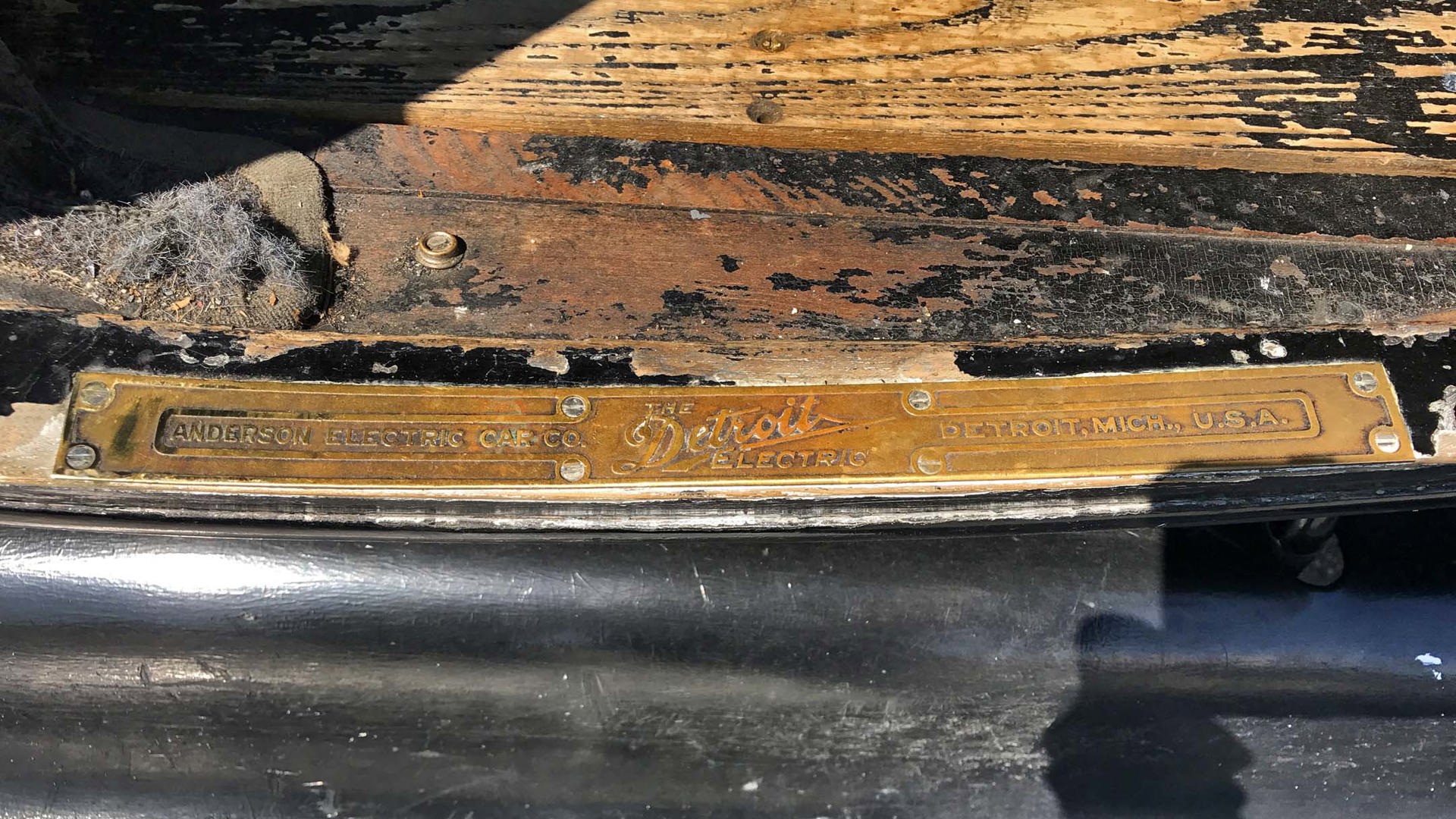Perhaps the most popular electric car at the recent Vancouver Electric Vehicle Association (VEVA) electric car show was an electric car that was built in 1912 – yes, that’s the same year that the RMS Titanic ocean liner sank to the bottom of the Atlantic ocean and explorer Roald Amundsen reached the South Pole.
Standing out from a parking lot full of sleek Teslas, Leafs, i-MiEVs and e-Golfs, the tall and stately 1912 Detroit Electric Model 31 Brougham drew onlookers of all ages, from wide-eyed five year-olds to knowledgeable electric-car aficionados to admiring senior citizens – some of whom could remember seeing this very car being driven around Victoria, BC, by its then-owner Florence French.
Detroit Electrics were often purchased by doctors, wealthy professionals and industrialists but driven by their wives. Notable women drivers of the early 20th century included the wives of Thomas Edison, John D. Rockefeller Jr., Henry Ford, and Henry Joy (President of Packard). Florence French was the wife of wealthy Victoria veterinarian, Dr. Cecil French.

There were good reasons why women preferred electric cars in those days: they were quieter, more reliable, easier to drive, and easier to start than the noisy, smelly, greasy, and often unreliable internal combustion engine cars of the day. Until the invention of the electric starter in 1912, gasoline cars needed to be started with a hand-crank at the front of the car which was not only physically demanding but could kick back, knocking you out. As well, gasoline cars were notoriously unreliable with engines and radiators which often overheated, engines that wouldn’t start, and transmissions that were hard to shift.
This particular Detroit Electric Model 31 was purchased in Montreal in the fall of 1912 by Dr. French for the then-astronomical sum of $3,210, equivalent to the price of a large house at that time. A year later, he and his wife Florence moved to Victoria, British Columbia, bringing the Detroit Electric with them.
Dr. French and his wife continued to drive the Detroit Electric around Victoria until Dr. French’s passing in the 1940s when his wife took up residence at the iconic Empress Hotel on the Victoria waterfront. She had the car charged overnight in the hotel garage and delivered to the front door whenever she wanted to go out for a spin. Nicknamed the “Empress Dowager”, she drove the Detroit Electric regularly around town right up until the 1950s.
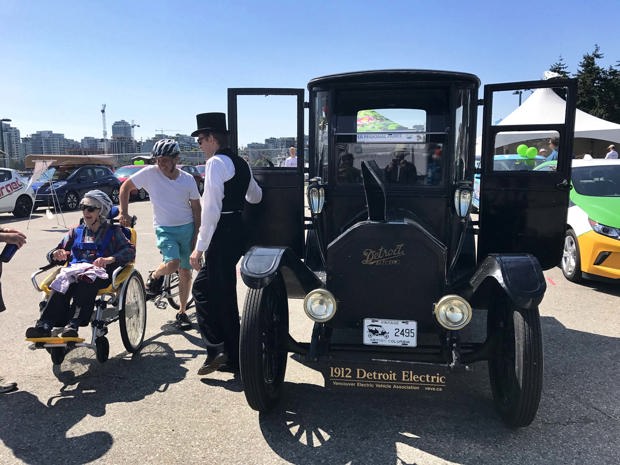
After Florence died in the 1960s, the car passed into private hands until it was purchased by the BC government as part of a car collection to be displayed at Expo 86. From there it moved to the BC Transportation Museum in Cloverdale near Vancouver until 1989 when the museum was closed.
“After the BC Transportation Museum closed, VEVA petitioned the government to take care of the car so that we could display it to the public and promote electric vehicles with it,” explained Hawkin McCallum, VEVA Chair of the Detroit Committee, which looks after the 1912 Detroit Electric (here appropriately dressed in early 20th Century garb complete with a top hat).
“This particular car is rare – it is the last remaining Detroit Electric car with the false radiator on the front. After 1912, they had a rounded front without the fake radiator.”
This partly restored Detroit Electric still runs just fine, mostly at special events; in the summertime it’s brought out for antique car shows, VEVA events, and is even available for VEVA members to take out for supervised driving lessons.
State-of-the-art in its day

Detroit Electrics were state-of-the-art in their day. Built by the Anderson Electric Car Company (later the Detroit Electric Car Company) founded by Ontario native William C. Anderson, approximately 13,000 Detroit Electric cars were built in Detroit from 1907 to 1939.
Lead-acid batteries were standard in 1912, but this Detroit Electric was equipped with optional Edison nickel-iron batteries which provided a longer life and better reliability. Amazingly, these original batteries continued to function for over 70 years – it wasn’t until their Bakelite battery cases started to leak electrolyte in the 1990s that the batteries had to be replaced.
With a range of up to 160 km, this 1912 Detroit Electric could go farther than many gasoline automobiles.
After 1990, the original nickel-iron batteries were replaced twice. It currently has sixteen 6V lead-acid golf-cart batteries producing 96 volts and charged by two 48V chargers. However, VEVA plans to locate the original nickel-steel batteries and have them rebuilt.

The original charger was a motor-generator. “That’s because in those days they didn’t have diodes,” says McCallum who is an electrical engineer by profession. “They had no easy way of turning AC, or whatever the wall has, into DC for the car. So they actually run the motor with the AC and run the generator which gives you the DC.”
In the early days, charging the car was a challenge because every electricity utility had different electricity standards: some were AC, some were DC. “Because of that, what they would do is just give you the motor that would suit your voltage that you had, and the generator would have been the same. We actually have the original motor-generator but we lost the control panel which would look something like Frankenstein’s control panel!”
Last year, VEVA rebuilt the motor speed controller and replaced the resistor, but the car’s original electric motor, which is underneath the cab, has never been serviced and still operates today.

Other notable features of the 1912 Detroit Electric Brougham are its aluminum body panels, mechanically actuated rear drum brakes instead of the more common cable brakes, and a shaft-drive instead of chain-drive. It currently has 34-inch wood-spoked wheels with pneumatic tires, but the original wheels were wire wheels with solid rubber tires; pneumatic tires in those days were notoriously unreliable.
The Detroit Electric’s original interior was luxuriously finished with royal blue leather seats, polished wood window frames, blue satin headliner, privacy blinds, wool carpeting and a crystal flower vase in one corner. Time has taken its toll on the cabin materials, but VEVA managed to re-upholster the seats in new black leather last year.
Reflecting its horse-carriage heritage, there are two ornate carriage lights at the front corners below the windscreen and one red lantern at the rear.
The driving experience

With two large, lightweight aluminum doors, a wide metal running board, and a tall roof, the Detroit Electric is easy to get into and out of, something that was probably appreciated by the ladies of the early 20th century in their floor-length skirts.
The cabin seats three people, two facing forward on a bench seat, and one facing backward on a fold-down jump seat. The cabin is bright and airy with a very tall roof that’s designed to accommodate the tall top hats of the day. The driver sits on the left and steers with a horizontal lever or tiller which flips down from the wall. The accelerator is also a horizontal lever with five speeds: 5, 8, 13, 17, and 20 mph, engaged one at a time. The throttle tiller also acts as a brake when pulled back by shutting off the electric motor. Two brake pedals on the floor actuate the rear drum brakes – the right pedal is the primary brake while the left pedal locks the brakes like a parking brake.
When driving, the left hand is placed on the shorter throttle lever while the right hand is on the longer steering tiller. “It’s similar to locomotives and the cable cars in San Francisco,” says McCallum.

On the floor near the brake pedal is a watt-hour meter that indicates how much charge is left in the battery pack.
Due to insurance concerns and my inexperience driving a car without a steering wheel, I wasn’t permitted to drive the Detroit Electric, so I asked VEVA rep Hawkin McCallum to describe what it’s like to drive.
“Surprisingly little effort is required to drive it. but you’d be amazed how quickly it can get away from you,” he enthuses. “Steering is light once under way, and it tracks quite well, but does follow the odd rut in the road with those narrow tires. It’s a very comfortable car, with a soft ride, and easy to drive.”
Its main weakness, he says, is the brakes.

“It does very well going up hills, but going downhill the brakes are weak because brakes of the day weren’t very good. You really have to look ahead and brake early. But that wasn’t unusual in those days. Model T brakes were just the same.”
The fact that the 105-year-old Detroit Electric is still running today is a testament to the simplicity and reliability of electric drivetrains. With its battery pack, controller, and electric motor, the Detroit Electrics drivetrain isn’t really much different from those of today’s electric cars.
If you’re in Vancouver, you can see the 1912 Detroit Electric Model 31 Brougham on display at the Stave Falls BC Hydro Powerhouse Museum in Mission, near Vancouver – which coincidentally, was also built in 1912.





